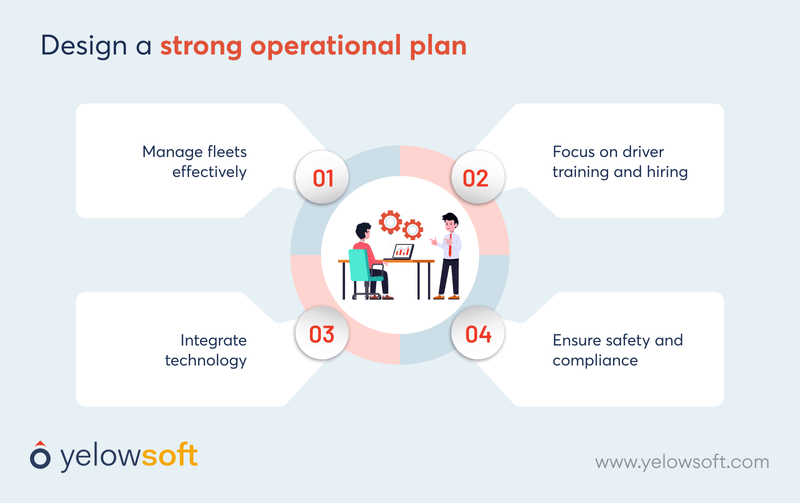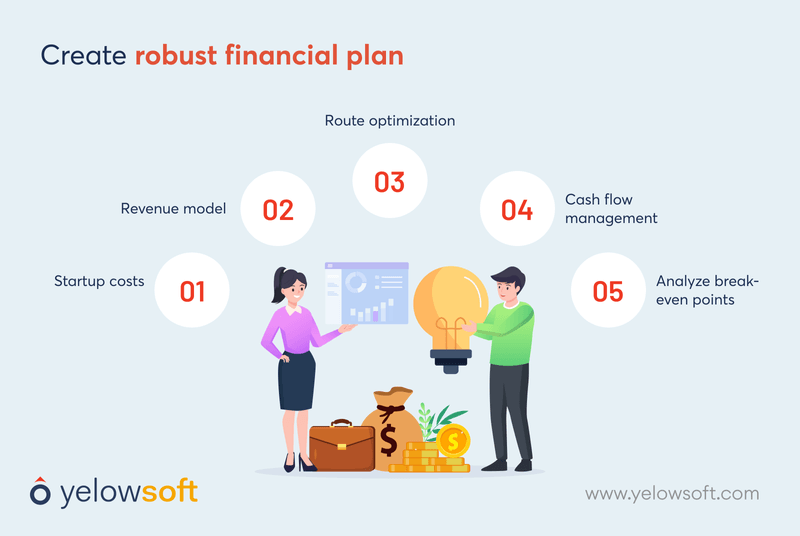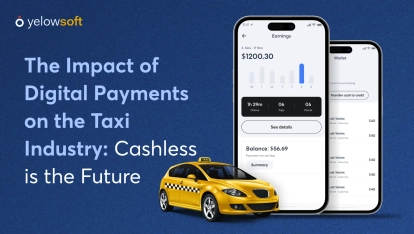A goal without a plan is just a wish. And if your goal is to start a successful taxi business from scratch, then having a reliable plan is a must.
Whether you are an aspiring entrepreneur, an investor looking to invest in the taxi business, or an existing taxi service provider looking to expand your business, considering a solid business plan to start a successful taxi business is the very first step.
This comprehensive guide will break down the overall plan into pieces and help you with valuable insights and actionable steps to set up a taxi business.
Let’s start by understanding the taxi industry.
Understand the taxi industry
Before you dive into making the business plan, it’s crucial to have a clear picture and understand everything about the taxi transfer industry. Here is what you can do.
Explore current market trends
Ride-hailing apps, taxi dispatch software, airport transfer software, limo booking software, corporate taxi transfer software, car rental software, etc. have changed the old tradition of doing taxi transfer business.
Technology has played a vital role in changing the taxi industry in recent years. It has also shifted consumer preferences.
According to Statista, the taxi market worldwide is expected to generate a revenue of US$153.40bn in 2024 and is expected to reach US$161.1bn by 2028 at a CAGR of 1.23%.
Ride-hailing apps have revolutionized how people book and use taxi services.
To stay competitive, it's essential for you to stay updated on these trends.
Note: If you have made up your mind to build a clone app like Uber. Then there is a ready-to-use app available for you.
Read More: The most reliable Uber clone app
Know the key players
Identifying the successful and key players in the taxi industry will help you gain valuable insights into successful business models and strategies.
Companies like Uber, Lyft, etc. are some of the key players in the taxi industry. These companies have set new standards for passengers and taxi business owners. The focus is on convenience, safety, and affordability.
Analyze these companies, see how they work, the innovations they have adopted and more. This will give you an idea of what you should do for your business's success.
Identify opportunities and challenges
Every industry comes with opportunities and challenges. So does the taxi industry too.
In the taxi industry, there is a growing demand for reliable and convenient transportation services.
According to imarcgroup, the global taxi market size is expected to reach US$ 357.9 billion by 2032 at a CAGR of 4.9% during 2024-2032.
In the current era, the opportunity to grow is due to the adoption of technology and softwares like taxi dispatch software.
However, there are challenges as well that you have to consider such as regulatory compliance, competition, and fluctuating fuel prices.
By understanding these dynamics, you can develop strategies to capitalize on opportunities and mitigate risks.
Note: If you are planning to start a taxi business in specific regions like, check our blog on.
And if you are from South Africa and looking to start a taxi business from scratch, then this blog is a must-read for you.
What things are required to start a taxi business in a small town in South Africa
By doing all these activities, you will have a sound understanding of the taxi industry. Let’s now see the next necessary step in creating a dashing plan.

Executive summary
The executive summary is a snapshot of your business plan. It is created to get a high-level overview of your business. Below you will explore the key step of an executive summary and how to create it.
Define your business concept
Decide and describe what you as a taxi business owner would like to offer. Would you like to offer all types of taxi transfer services or offer specific like;
- Ride-hailing
- Limo transfers
- Airport transfers
- Corporate transfers
- Car rentals and more…
Clearly outline your business model and steps that will make your service unique.
Craft your value proposition
Highlight what will set your taxi transfer service apart from the competition. This could be;
- Superior customer service
- Innovative technology
- Eco-friendly vehicles, or
- Competitive pricing
By defining a value proposition, you can attract and retain customers, drive growth, and achieve long-term success.
Set your vision and mission
Share your long-term goals and the core purpose of your business. Your vision statement should articulate what you aspire to achieve in the future.
And your mission statement should explain the fundamental purpose of your business and how you plan to achieve your vision.
Financial projections
Financial projections help you forecast your company’s financial performance. You can make a brief overview of the expected financial performance that includes metrics like;
- Projected revenue
- Profitability, and
- Return on investment
Accurate financial projections can greatly impact your company’s success.
Conduct in-depth market analysis

Here you will learn how to identify market needs, assess demand, and develop strategies to effectively compete in the market.
Know your target customers
Define who your target audience is. Know who your ideal customers are. To know your target customers better, you can think about demographics, preferences, and needs.
For example, if you are planning to offer your taxi transfer service in urban areas, your target customers would be different. They could be;
- Professionals
- Tourists
- Local residents, etc.
This will help you get a clear understanding of your target audience. You can also develop a business plan that will increase the chances of success for your taxi business.
Evaluate the market needs and demand
Conducting market research can help you identify gaps in the current market. This will help you understand;
What specific needs does your service address? What customers are looking for in a taxi service? And more…
This could include factors such as reliability, affordability, convenience, and safety.
Perform detailed and smart competitor analysis
Evaluate your competitors’ strengths and weaknesses. Find;
- Who are your competitors
- What they are doing well
- Where they are falling short
- Their product strengths and weaknesses
- And more…
By analyzing your competitors in detail, you can get valuable insights into industry trends. Plus, it will also help you identify opportunities for differentiation.

Do SWOT analysis
Let me first clarify what is SWOT analysis.
S - Strength
W - Weakness
O - Opportunities
T - Threats
Conduct a SWOT analysis to identify your strengths, weaknesses, opportunities, and threats.
This will help you develop strategies to leverage your strengths, address your weaknesses, capitalize on opportunities, and mitigate potential threats.
Majority of the taxi businesses find themselves weak in adopting the technology or having reliable taxi booking app software that can help them revolutionize their business and drive profit beyond expectation.
Hence, if you find yourself weak in the technology area and feel it is a threat to not having an advanced taxi dispatch software, then give your doubt a reasonable answer by reading this blog.
Read More: Why your cab business needs advanced taxi dispatch software.
Finalize what service you’ll offer
After you are done with the in-depth market analysis, define the range of taxi transfer services you will provide. Define the range of services your taxi business will provide.
Choose the service types
Yes. Here, you can outline the types of taxi transfer services you will offer. The types of service include:
- Ride-hailing services
- Airport transfer services
- Corporate transfer services
- Limo transfer services
- Car rental services
- Taxi dispatch services
- Or many more based on the market analysis
Make pricing strategy
Make the pricing strategy for your taxi business carefully. Your pricing strategy should consider factors like;
- Operational cost
- Market demand
- Competitor pricing
If you create strategic pricing for your various services, you can maximize revenue and achieve long-term sustainability.
Offer additional services
Offering additional services can set your business apart and better from the competitors. Additional services include offering your passengers to book rides with a mobile app or website, loyalty programs, carpooling, etc. This enhances customer satisfaction and profit levels.
In addition, it also helps you attract new customers and retain old customers.
Create a winning marketing and sales strategy
Your marketing and sales strategy will drive customer acquisition and growth.

Below you will explore what steps you can follow to create a winning marketing and sales strategy.
Create strong brand and position
Create a strong brand identity that resonates with your target customers. Your branding should convey your value proposition and differentiate your business from competitors. This includes your;
- Business name
- Logo
- Tagline
- And overall brand messaging
Choose various marketing channels
There are 2 marketing channels - offline and online. You should choose both markets for your business effectively.
To market your business online, you can choose platforms like;
- Social media
- Search engine marketing
- Online advertisements
On the other hand, offline channels may include;
- Flyers,
- Billboards
- Local partnerships
Choosing both channels will help you reach a wide audience.
Plan for customer acquisition
Develop strategies to attract and retain customers. And you can do this by providing excellent customer service and positive customer experience.
Along with these, you can offer promotional offers, referral programs, and partner with local businesses to acquire more customers.
More importantly, today’s advanced taxi businesses acquire customers by offering them smart booking services and experience. And they are able to do that because of the taxi booking software.
Explore: How the best taxi dispatch system features can level up your dispatch business
Design a strong operational plan
A great operational plan is the secret to great success for a business like Uber.

Your operational plan should cover everything from vehicle management to driver recruitment and technology integration. Let us explore each of them in detail below.
Manage fleets effectively
Effective fleet management is crucial for the smooth operation of your taxi business. This includes:
-
Vehicle selection: Choose reliable and fuel-efficient vehicles that meet the needs of your target customers.
-
Maintenance: Regularly service your vehicles to ensure they remain in good condition.
-
Logistics: Plan routes and schedules to optimize efficiency and minimize downtime.
The bad thing about manual fleet management is, that there are high chances that you will miss either 1 or a minimum 2 from the above 2 when it comes to managing fleets.
Companies like Uber use fleet management software also known as taxi dispatch platform that gives an alert (notification) when your fleet requires maintenance.
It also gives you data about fuel consumption and routes it traveled. With this data, you can make informed decisions for adding upcoming vehicles.
Read more: 5 issues a good fleet management solution can solve
Focus on driver recruitment and training
Attracting and retaining skilled drivers is essential for you to provide a high-quality taxi transfer service. This involves:
- Recruitment: Develop a strategy to attract qualified drivers. This could include;
- Job postings
- Referrals
- And partnerships with driving schools
- Training: Provide comprehensive training to your drivers to ensure they are knowledgeable about;
- Safety protocols
- Customer service
- And technology use
Technology integration
Uber is successful because of its technology integration and adoption.
Implementing advanced technology like white-label taxi dispatch software can be a success secret for you as well.
It can streamline your operations and improve the customer experience. The technology integration includes:
- Taxi dispatch software: Use reliable SaaS-based taxi dispatch software to manage your bookings, dispatch drivers, and track vehicles in real time.
-
GPS tracking: You can either integrate this feature alone. Or use a ready-to-use taxi booking app that comes with a GPS tracking feature and allows you to track and monitor fleets while optimizing routes.
-
Customer app: Offer a user-friendly app to your customers and allow them to book rides at their fingertips. The app also allows users to track drivers and make payments.

Safety and compliance
Ensuring the safety of your customers and drivers is paramount. And to offer safety to your customers, you can use;
-
Safety protocols: Implement strict safety protocols and regularly review them to ensure they are up-to-date. One of the ways to ensure safety is by using white-label taxi booking software that comes with advanced safety features.
-
Compliance: Ensure your business complies with all local regulations and industry standards. This includes licensing, insurance, and vehicle inspections.
Create your financial plan
A robust financial plan is essential for securing funding and managing your business finances.

This heading will help you learn about startup costs, revenue models, profit and loss projections, cash flow management, and more.
Startup costs
As you are starting your business, it becomes extremely crucial for you to understand the startup cost. This will help you determine how much funding you need to kickstart your business.
The cost to start a taxi business may include initial expenses like,
- Including vehicle purchases
- Technology integration
- Marketing, and administrative costs
Revenue model
A well-structured revenue model helps you determine the profitability of your taxi company. It tells you how your business will make money.
While creating a revenue model, you should define pricing strategy, projected revenue streams, and expected profitability.
A revenue model for your taxi business typically will include;
- Fare structures
- Payment processing
- Pricing strategies
Profit and loss projections
Estimate your profitability over a specific period, typically three to five years.
This should include;
- Projected revenue
- Operating expenses
- And net profit
Regularly review your profit and loss projections as it will help you identify areas for improvement. And ensure your business remains financially healthy.
Cash flow management
For the sustainability of your business in the market, it is essential to ensure you have enough cash flow. The cash flow management includes;
- Cash flow forecasting
- Managing expenses
- Building reserves
Analyze your break-even points
Determine when your business will start making a profit by conducting a break-even analysis.
This involves calculating your fixed and variable costs to understand how many rides or services you need to provide to cover your expenses.
This analysis will help you set realistic financial goals and measure your progress towards profitability.
Management and organization
Describe your taxi business structure and key team members.

This section will detail how your business will be managed and who will be responsible for key roles.
Organizational structure
Define the roles and responsibilities within your business. This could include:
-
Executive team: Owners, founders, and top-level managers responsible for strategic decision-making.
-
Operations manager: Oversees daily operations, fleet management, and driver coordination.
-
Marketing manager: Develops and implements marketing strategies to attract and retain customers.
-
Finance manager: Manages financial planning, budgeting, and accounting.
Key team members
Highlight the expertise and experience of your key team members. This could include their
- Backgrounds
- Qualifications
- And previous successes
A strong team with relevant experience can increase your confidence. And also contribute to the overall success of your business.
Conclusion
Creating a business plan for your taxi business might seem daunting. But with careful planning and the right resources, you can set a strong foundation for success. Remember, utilizing advanced tools like Yelowsoft’s cloud based taxi dispatch software can streamline your operations and give you a competitive edge.
By following the steps outlined in this blog, you can develop a comprehensive and effective business plan that covers all critical aspects of your taxi business. This will not only help you secure funding and attract investors but also provide a roadmap for achieving your business goals.
Take the first step towards your dashing taxi business today. And turn your vision into reality with a well-crafted business plan.





